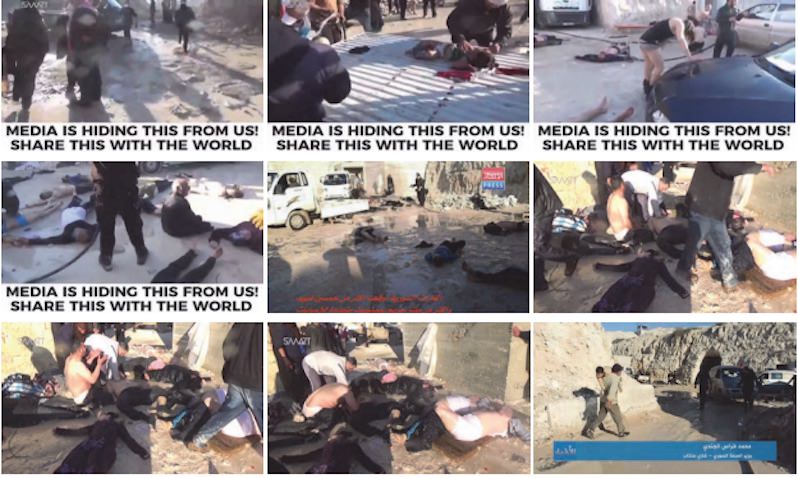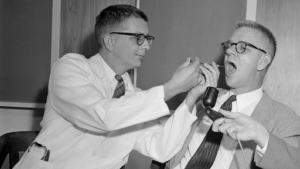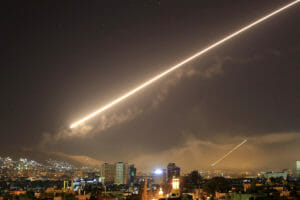The Nerve Gas Attack Described in White House Report Did Not Occur, Expert Says of Syria Incident
Some kind of poisoning event may have produced mass casualties on April 4, but the White House Intelligence Report did not accurately describe that event, a weapons specialist from MIT writes.
By Theodore A. Postol
Video frames from the location in Khan Shaykhun where mass casualties either occurred or were being treated. (The wording below some of the images is embedded in the original recordings.)
Theodore A. Postol is professor emeritus of science, technology and national security policy at the Massachusetts Institute of Technology and a specialist in weapons issue. At the Congressional Office of Technology Assessment, he advised on missile basing, and he later was a scientific consultant to the chief of naval operations at the Pentagon. He is a recipient of the Leo Szilard Prize from the American Physical Society and the Hilliard Roderick Prize from the American Association for the Advancement of Science, and he was awarded the Norbert Wiener Award from Computer Professionals for Social Responsibility for uncovering numerous and important false claims about missile defenses.Editor’s note: This article about the alleged nerve agent attack in Khan Shaykhun, Syria, earlier this month contains an important error that Theodore A. Postol has corrected in a new report, posted April 21 on Truthdig.
This analysis contains a detailed description of the times and locations of critical events in the alleged nerve agent attack on April 4 in Khan Shaykhun, Syria. The conclusion assumes that the White House Intelligence Report (WHR) issued on April 11 correctly identified the alleged sarin release site.
Analysis using weather data from the time of the attack shows that a small hamlet about 300 meters to the east-southeast of the crater could be the only location affected by the alleged nerve agent release. The hamlet is separated from the alleged release site (a crater) by an open field. The winds at the time of the release would have initially taken the sarin across the open field. Beyond the hamlet there is a substantial amount of open space, and the sarin cloud would have had to travel a long additional distance for it to have dissipated before reaching any other population center.
READ: A Critique of ‘False and Misleading’ White House Claims About Syria’s Use of Lethal Gas
Video taken on April 4 shows that the location where the victims were supposedly being treated for sarin exposure is incompatible with the only open space in the hamlet that could have been used for mass treatment of victims. This indicates that the video scenes where mass casualties (the dead and dying) were laid on the ground randomly was not at the hamlet. If the location where the bodies were on the ground was instead a site where the injured and dead were taken for processing, then it is hard to understand why bodies were left randomly strewn on the ground and in mud as shown in the videos.
The conclusion of this summary of data is obvious—the nerve agent attack described in the WHR did not occur as claimed. There may well have been mass casualties from some kind of poisoning event, but that event was not the one described by the WHR.
The findings of this analysis can serve two important purposes:
1. It shows exactly what needs to be determined in an international investigation of this alleged atrocity. In particular, if an international investigation can determine where casualties from the nerve agent attack lived, it will further confirm that the findings reported by the WHR are not compatible with the data it cites as evidence for its conclusions.
2. It also establishes that the WHR did not utilize simple and widely agreed upon intelligence analysis procedures to determine its conclusions.
This raises troubling questions about how United States political and military leadership determined that the Syrian government was responsible for the alleged attack. It is particularly of concern that the WHR presented itself as a report with “high confidence” findings and that numerous high-level officials in the U.S. government have confirmed their belief that the report was correct and to a standard of high confidence.
Methodology Used in This Analysis
The construction of the time of day at which particular video frames were generated is determined by simply using the planetary geometry of the sun angle during the day on April 4. The illustration below of the sun-angle geometry shows the Day/Night Sun Terminator at the location of Khan Shaykhun on April 4. The angle of the sun relative to local horizontal is summarized in the table that follows the image of the planetary geometry along with the temperature during the day between 6:30 a.m. and 6 p.m.
The next set of two side-by-side images shows the shadows at a location where a large number of poison victims are being treated in what appears to be the aftermath of a poisoning event. The shadows indicate that this event occurred at about 7:30 a.m. This is consistent with the possibility of a nerve agent attack at 7 a.m. on April 4, and it is also consistent with the allegation in the WHR that an attack occurred at 6:55 a.m. on that day.
The timing sequence of the attack is important for determining the consistency of the timelines with the allegations of a sarin release at the crater identified in the WHR.
Assuming there was enough sarin released from the crater identified by the WHR to cause mass casualties at significant downwind distances, the sarin would have drifted downwind at a speed of 1 to 2 meters a second and for several minutes before encountering the only location where mass casualties could have occurred from this particular release. The location where these mass casualties would have had to occur will be identified and described in the next section. If there was a sarin release elsewhere, mass casualties would have not occurred at this location but would have occurred somewhere else in the city.
Assuming the victims of the attack were exposed to the plume, the symptoms of sarin poisoning would have expressed themselves almost immediately. As such, the scene at 7:30 a.m. on April 4 is absolutely consistent with the possibility of a mass poisoning downwind of the sarin-release crater.
The next figure shows the earliest photograph we have been able to find of an individual standing by the sarin-release crater where the alleged release occurred. The photo was posted on April 4, and the shadow indicates the time of day was around 10:50 a.m. Thus the individual was standing by the crater roughly four hours after the dispersal event.
If the dispersal event was from this crater, the area where this unprotected individual is standing would be toxic, and this individual would be subjected to the severe and possibly fatal effects of sarin poisoning. As a result, this throws substantial suspicion on the possibility that the crater identified by WHR would be the source of the sarin release.
At the time of the sarin release, the temperature of the air was about 60 degrees Fahrenheit, and the sun was at an angle of only 8 degrees relative to local horizontal. This means that liquid sarin left on the ground from the dispersal event would remain mostly unevaporated. By 11 a.m., the temperature of the air had risen to 75 degrees, and the angle of the sun relative to horizontal was at 66 degrees. Thus, one would expect that the combination of the rise in air temperature and the sun on the crater would lead to significant evaporation of liquid sarin left behind from the initial dispersal event. The air temperature and sun angle are such that the area around the crater should have been quite dangerous for anybody without protection to operate.
This is therefore an important indication that the crater was probably not a dispersal site of the sarin.
The final set of three photographs shows arriving victims seeking treatment at a hospital at some location in Khan Shaykhun. The arrivals at the hospital are between 9 a.m. and 10:30 a.m. on the day of the attack. This is perhaps late since victims were seriously exposed by 7:30 a.m., but victims could have been trailing in after the initial arrival of severely affected victims. This time is considerably earlier than the time at which WHR alleges that a hospital was attacked while treating victims of the poisoning attack.
In the next section, we discuss the location where mass casualties would have occurred if the sarin release occurred at the location alleged by the WHR.
Sun shadows at about 7:30 a.m. on April 4 at a location where large numbers of victims from a poisoning event were being treated.
A man without protective equipment standing next to the crater at 10:50 a.m. on April 4 — roughly four hours after the sarin release alleged by the WHR.
Victims arriving at a hospital in Khan Shaykhun between 9 a.m. and 10:30 a.m. on April 4 following the mass casualty event observed at 7:30 a.m.
An image from about 10:30 a.m. in Khan Shaykhun suggesting a possible additional location where casualties were generated from a poisoning attack.
Identification of the location of the mass casualties.
The figure on the next page shows the direction of the toxic sarin plume based on the assumption that the alleged release point was the crater identified by the WHR. The wind conditions at the time of the release, which would have been at about 7 a.m. on April 4, would have carried the plume across an empty field to an isolated hamlet roughly 300 meters downwind from the crater.Although there were some walls and structures that would have somewhat weakened and inhibited the movement of the aerosol cloud from the release point, the open field would be an ideal stable wind environment to transmit the remaining sarin cloud with minimal distortion and dispersal. As such, with the weather conditions at that time, it is plausible that the sarin cloud could have led to mass casualties at the hamlet.
The sarin dosage level that results in 50 percent of exposed victims dying is known as the LD50. The LD50 for sarin is about 100 mg•min/m3.
The dose quantity mg•min/m3 can be understood simply.
An exposure of about 100 mg•min/m3 simply means that a victim is within an environment for one full minute when there is 100 mg/m3 of sarin in the air. If the victim is instead in an environment for 10 minutes where there is a density of sarin of 10 mg/m3, he or she will also receive a lethal dose of 100 mg•min/m3.
Assuming 5 to 10 liters were aerosolized at the crater as alleged by the WHR, this would have resulted in an average sarin exposure at the hamlet at the 300-meter range of about 10 to 20 mg•min/m3, assuming wind and temperature conditions that are near ideal for lethal exposures downwind. This estimate assumes that an individual would be outside and exposed to the sarin as the gas cloud passes by.
Postulated movement of sarin aerosol and gas cloud in the local winds at 7 a.m. on April 4 from the release crater alleged by the WHR.
Video details of the release site taken from a small drone launched by a television crew.
Video details of the release site overlaid on a Google Earth image of the sarin release and casualty locations from the attack alleged by the WHR.
Details of the hamlet where mass casualties would have occurred if the WHR allegations were correct.
Since a cloud of sarin would not be uniformly mixed, there will be regions in the cloud that have much higher and lower doses than the average. In addition, as the cloud passes, sarin entering into open windows of aboveground and basement rooms would tend to become trapped inside these rooms, creating a significantly longer exposure to the nerve agent, certainly leading to lethal levels if residents did not evacuate the rooms immediately. Also, since the nerve agent cloud would be passing through an area that has buildings, it will tend to flow around and over buildings and down into open basement windows, resulting in buildups of sarin in some locations and diminished levels of sarin at other locations.As a result, the hamlet could well have been within lethal range of the sarin exposure. However, areas further downwind from the hamlet would be far enough away for the sarin to disperse sufficiently so that it would not be capable of causing deaths.
Thus, the hamlet area 300 meters downwind of the crater is the only area where mass casualties could occur, if there had been a sarin release at the crater as alleged by the WHR.
The selected video frames collected on the next two pages show three important sets of data that indicate the following:
1. Unprotected civilians with clothing that have logos of the Idlib Health Directorate are tampering with the contents of the crater that the WHR alleges was the source of the sarin release. All indicators point to a ruptured tube that could have contained no more than 8 to 10 liters of sarin. This is the only container shown in any videos from this scene.
2. The next collection of video frames shows panoramic views of the target area taken from a drone equipped with a video camera. As can be seen in the video frames, a goat that was allegedly killed from the sarin dispersal is close to downwind of the alleged dispersal site. However, the hamlet that should have experienced major casualties, if the alleged dispersal site had been correctly identified, is only 300 meters downrange, and easily reachable by simply walking over to the site.
Yet none of the video journalists refer in any way to a mass casualty site nearby. They simply focus on a dead goat and present out-of-context images of a few dead birds. It is remarkable that no video journalists—of the many who reported from this crater area—referred in any way to the mass casualties that could only have occurred 300 meters away, if the attack had been executed from this crater.
3. The last collection of 18 video frames is from the area where mass casualties were piled on the ground haphazardly. They were dead or dying. Among these casualties were infants as well as men and women. This scene clearly could not have been at the location of the hamlet as one can see that the walls surrounding the area are carved out of rock. Thus, this scene could not possibly have been at the hamlet.
These video frames were generated by reviewing hundreds of videos posted on YouTube, plus additional videos and video frames found on Twitter.
Among the hundreds of videos reviewed, there seems to be no more than 50 to 60 seconds of actual original scenes like those laid out in the collection of 18 videos below. The vast majority of time in the videos contains the same repeated sequences of the same dead and injured infants and adults that could all be collected into less than a couple of minutes of independent scenes.
The overwhelming evidence is these videos repeat nothing more than redundant scenes that suggest one terrible event might have occurred. Almost none of the scenes contain any different information from the others. This raises a serious question about how much real data has been supplied that would indicate an actual significant nerve agent attack.
What is absolutely clear from the videos is the location of the sarin dispersal site alleged by the WHR and the mass casualty site that would have been produced if the sarin dispersal actually occurred are not in any way related to the scenes of victims shown in the other videos. The conclusion is obvious: The alleged attack described in WHR never occurred.
Unprotected officials from Idlib Health Directorate tampering with the crater at the alleged location of sarin release.
Panoramic of area around the alleged location of the sarin release where the dead goat was found and the hamlet where mass casualties would be expected to have occurred.
Video frames from the location where mass casualties either occurred or victims were being treated.
Final Comments
This abbreviated summary of the facts has been constructed entirely from basic physics, video evidence and solid analytical methods. It demonstrates without a doubt that the sarin dispersal site alleged as the source of the April 4 sarin attack in Khan Shaykhun was not a nerve agent attack site.
It also shows beyond a shadow of a doubt that the only mass casualty site that could have resulted from this attack is not in any way related to the sites shown in the video alleged to have been made following a poisoning event of some kind at Khan Shaykhun.
This means that the allegedly “high confidence” White House intelligence assessment issued on April 11, which led to the conclusion that the Syrian government was responsible for the attack, is not correct. For such a report to be so egregiously in error, it could not possibly have followed the most simple and proven intelligence methodologies to determine the veracity of its findings.
Since the United States justified attacking a Syrian airfield on April 7, four days before the flawed National Security Council intelligence report was released to Congress and the public, the conclusion that follows is that the United States took military actions without the intelligence to support its decision.
Furthermore, it is clear that the WHR was not an intelligence report.
No competent intelligence professional would have made so many false claims that are totally inconsistent with the evidence. No competent intelligence professional would have accepted the findings in the WHR analysis after reviewing the data presented herein. No competent intelligence professionals would have evaluated the crater that was tampered with in terms described in the WHR.
Although it is impossible from a technical assessment to determine the reasons for such an egregiously amateurish report, it cannot be ruled out that the WHR was fabricated to conceal critical information from Congress and the public.
Appendix
Resource materials used to determine local weather conditions and sun angles needed to verify the above analysis.
Theodore A. Postol can be reached at [email protected].
Your support matters…Independent journalism is under threat and overshadowed by heavily funded mainstream media.
You can help level the playing field. Become a member.
Your tax-deductible contribution keeps us digging beneath the headlines to give you thought-provoking, investigative reporting and analysis that unearths what's really happening- without compromise.
Give today to support our courageous, independent journalists.





You need to be a supporter to comment.
There are currently no responses to this article.
Be the first to respond.